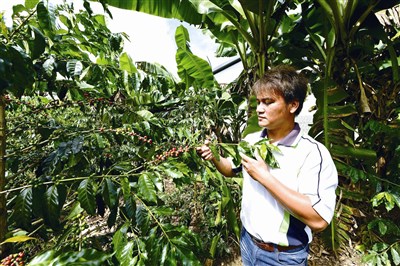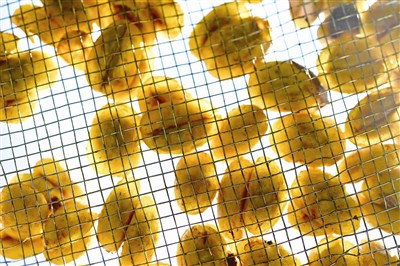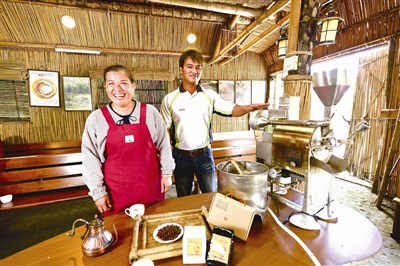 迦納納部落打造植物森林,混種咖啡與其他作物,達到病蟲害防治的效果。 圖/莊坤儒
迦納納部落打造植物森林,混種咖啡與其他作物,達到病蟲害防治的效果。 圖/莊坤儒 咖啡豆「蜜處理」曝曬,太陽下呈金黃色,咖啡喝起來有焦糖香氣。圖/莊坤儒
咖啡豆「蜜處理」曝曬,太陽下呈金黃色,咖啡喝起來有焦糖香氣。圖/莊坤儒 迦納納部落發展協會理事長陳玉英(左),以及合作農場經理黃正宏,把關迦納納綠生咖啡的品質。圖/莊坤儒
迦納納部落發展協會理事長陳玉英(左),以及合作農場經理黃正宏,把關迦納納綠生咖啡的品質。圖/莊坤儒
提 要
花蓮瑞穗阿美族迦納納部落,
結合具有相同理念的部落族人,
成立合作農場,推廣友善生態農作,
生產的咖啡,供不應求。
Originating in the Central Mountain Range, the Xiu-gu-luan River flows north through the East Rift Valley, before turning east in Hua-lien County’s Rui-sui Township, cutting through the coastal mountains, and tumbling into the sea. A great place for whitewater rafting, Rui-sui is also a center of agriculture and animal husbandry. The township contains an area of fertile tablelands known as Wuhe.
Because of the steep basin topography, the Amis living in Wuhe call the area Kalala, which means ''basket.''
The area's pomelos and black tea are famous throughout Taiwan. Wuhe’s Amis elders still remember how the Japanese carved out coffee plantations on 400 hectares in Wuhe’s tablelands 200 meters above sea level.
A strong foundation for coffee production was thus established in Wuhe during the Japanese era. Consequently, when the coffee drinking culture was getting established in Taiwan ten-some years ago, it triggered a revival of coffee planting in Ka-lala.
Now 37, Huang Zheng-hong is an Amis who married a woman from Ka-lala. After he suffered an injury, he and his wife moved back to her hometown, where he joined the local development association and ended up volunteering to serve as manager of the farming co-op.
Huang explains that the biggest difference between the co-op and regular farms is the crop diversity on display in the co-op’s fields. For instance, next to a coffee tree you might find any of a variety of crops, including lemons, sweet potatoes and bananas.
Huang explains that growing diverse ''companion'' crops creates a ''planted forest'' that repels damaging insects.
Consequently, the co-op doesn't need to spray pesticides or engage in heavy weeding, and instead relies completely on the ecological balance to prevent insect damage. Last year it harvested about 1200 kilograms of ripe coffee, which yielded about 120 kilos of coffee beans after roasting. It sells five to 25 pounds of packaged coffee beans in an average month.
Executive director Chen Yu-ying explains that the ''pulped natural,'' a.k.a. ''honey'' processing method gives Ka-lala coffee its special character. ''The way the coffee cherries are dried is what makes this method special.''
After the ripe coffee ''cherries'' are picked and their skins removed, a layer of fleshy fruit pulp remains attached to the beans. The so-called ''honey treatment'' is achieved by laying the beans to dry out under the sun along with the pulp.
Because the fruit contains both gelatin and water, if the weather is poor during the first three days that the beans are laid out with the fruit pulp still attached, or if one doesn’t frequently turn them, they can easily go bad or mildew. But if you handle them just right, then the drying fruit will give the beans a higher sugar content, and the coffee brewed from them will be sweeter.
That method of processing the beans is hardly unique to Ka-lala. But honey treatments are employed there, says Huang Zheng-hong, as a result of the topography. Since-water supplies are so limited, the locals typically don’t wash the beans like growers do elsewhere.
The farming co-op in Ka-lala harvests pineapples in March and April and rice in May and June. In July the members take a break and prepare for the harvest festival. In August and September they harvest pomelos, and they start harvesting coffee in October, before preparing for a new rice crop in November.
''It’s been a triple win for the people involved, for our tribal village, and for the farming industry,'' Chen says.
翻 譯
發源於中央山脈的秀姑巒溪,沿花東縱谷北流後,在花蓮縣瑞穗鄉東折、橫切海岸山脈形成湍流。這裡是泛舟的聖地,也是農牧業的重鎮,鄉裡有一個肥沃的台地,叫做舞鶴。
由於這裡的地形狀似凹槽,百年前,住在舞鶴的原住民阿美族人,稱這裡是「Kalala」(籃子),這是迦納納部落之名的由來。
「籃子」裡的文旦與紅茶,具有全國的知名度。舞鶴年長的阿美族人都還記得,日本人在海拔約二百公尺的舞鶴台地開墾四百公頃(相當於十六個台北市大安森林公園)的咖啡園。
舞鶴在日據時代就已奠定咖啡生產的基礎。因此,十幾年前國人喝咖啡風氣漸盛之時,迦納納部落也開始恢復咖啡栽植,並向曾經種過咖啡的老人家請教相關的農業知識。
現年三十七歲的迦納納部落阿美族女婿黃正宏,原本在都市工作,因身體受傷而隨妻子回到迦納納務農,加入部落發展協會後,義務擔任農場的無給職經理。
他表示,迦納納合作農場與一般農場最大的不同是:各類作物混合種植,幾乎沒有為單一作物隔開獨立栽種的區域。譬如在咖啡樹旁,可以看到檸檬、地瓜葉、香蕉等八竿子打不著的農作物。
他解釋說,這種「植物森林」的種法合乎「相生相剋」的道理,對某一作物有害的病蟲,會因相剋作物的存在而受到嚇阻或抑制。
因此,合作農場不噴農藥、除草劑,病蟲害防治全賴植物森林維持生態平衡,去年收成一千二百公斤咖啡果實,烘出約一百二十公斤的豆子,適當包裝、儲存之下,每月平均售出五至二十五磅的咖啡豆。
部落發展協會理事長陳玉英表示,強調「蜜處理」,是迦納納咖啡豆的特色,「要成就咖啡豆的基底,關鍵就在於日曬。」
採收下來的咖啡果實剝去表皮後,會露出一層果肉,所謂蜜處理,即在去皮後,留下這層果肉,連著果實其他部分一起曝曬。
由於果肉富含膠質與水分,如果曝曬前三天天氣不好,或沒有經常加以人工翻攪,豆子很容易反潮、發霉;但如果處理恰當,會有較多的甜度及焦糖味。
這種處理豆子的方式,並非迦納納部落獨有。之所以特別強調,黃正宏表示,是因部落處在籃子狀地形的凹槽處,用水取得有限,為了減少水資源浪費而不用一般的水洗法處理豆子。
根據農作物生長的季節,迦納納合作農場三、四月採收鳳梨,五、六月收稻,七月休息準備豐年祭;八、九月收文旦,十月開始收咖啡,十一月準備新一季的稻米耕作。
這是「人、部落、產業的三贏,」陳玉英說。
文/朱立群
圖/莊坤儒
(摘錄轉載自102年12月《台灣光華雜誌》全文請參考http://www.taiwan-panorama.com/)